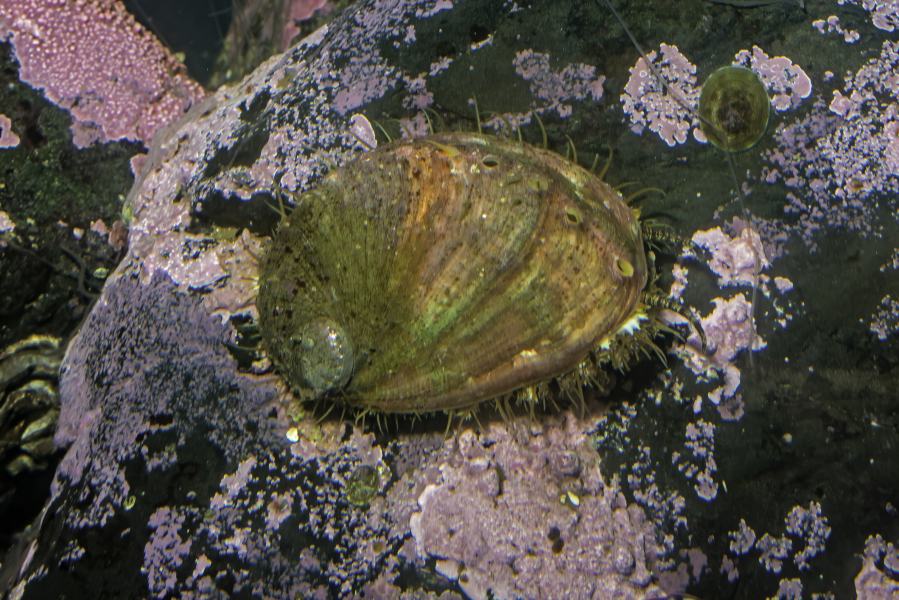BELLINGHAM — A marine snail on the brink of extinction is getting help from Whatcom researchers and the Lummi Nation as Washington expands restoration efforts for the pinto abalone.
The pinto abalone is the only abalone species native to Washington waters, contributing to healthy kelp forests that support a food web including orca and salmon. They are culturally significant to and a traditional food for Coast Salish tribes.
“They are like the Roombas keeping the seafloor clean and allowing other settling invertebrates and kelp to grow in those spaces,” said Katie Sowul, a biologist working on pinto abalone restoration at Washington’s Department of Fish and Wildlife.
But these ocean critters are coveted by humans for their iridescent shells and world-renowned meat, which can fetch $125 a pound. The pinto abalone has been overfished and poached to the point where a natural rebound in the Salish Sea is unlikely. Between 1992 and 2017, the number of pinto abalone found in surveys declined by 97 percent. Climate change piles more pressure onto the species: As humans continue to burn fossil fuels, the ocean absorbs more carbon dioxide and becomes more acidic, which can damage abalone shells.
“Abalone populations have plummeted in most parts of the world,” said Deb Donovan, a professor at Western Washington University’s biology department, at a university-organized event on Feb. 10.
Pinto abalone made headlines in 2019, when Washington designated the species as endangered. This decision opened up funding for restoration work and boosted public awareness for the pinto abalone, said Henry Carson, fish and wildlife research scientist at the Department of Fish and Wildlife.
But it could be a decade before biologists see real results, Sowul said.
Here’s how the restoration team operates: Divers collect wild pinto abalone and bring them to Puget Sound Restoration Fund’s hatchery in Manchester, where they are bred. The snails are broadcast spawners, meaning they don’t physically touch to reproduce. They release sperm and eggs into the water, which meet and form larvae smaller than a grain of sand. If abalone populations aren’t dense enough in the wild, the odds of successful reproduction go down.
Biologists raise the young abalone for 12 to 18 months, eventually releasing the juveniles in ideal pinto abalone habitat: smooth boulders covered in algae and kelp, with lots of crevices to hide from predators. Then the waiting game begins, until researchers return the following year to see how many juvenile abalones survived.
Last year, the team released about 10,000 juvenile pinto abalone across 10 sites near the San Juan Islands. (These sites are top-secret due to poaching concerns.) Current monitoring is showing some serious wins: One site had an 8 percent survival rate, which doesn’t include the abalone that were hiding where divers couldn’t see them.
“It seems low, but that species makes lots of babies. Lots don’t make it,” Sowul said. “That’s how grazers at the bottom of the food chain work.”
Moving forward
Now that the restoration team knows it can successfully outplant juvenile abalone, it looks forward to scaling up production and release work, WDFW scientist Carson said.
This momentum will likely carry the restoration efforts all the way to waters near Whatcom County. Lummi Nation is currently scouting locations with inviting pinto abalone habitat. Hatchery-raised abalone could be outplanted at these sites as soon as this year, Carson said.
Lummi Nation may eventually help raise pinto abalone at its shellfish hatchery, said Karl Mueller, the tribe’s shellfish biologist.
“Right now, we are literally sticking a toe in the water with site visits,” Mueller said.
Western Washington University researchers are also playing an important role in pinto abalone restoration. One graduate student’s work helped inform the type of phytoplankton the hatchery feeds very young abalone to best support survival and growth. Another student researched how to cryopreserve, or freeze, abalone sperm so that it can be used at a later date. (This gives researchers the ability to better control and maximize genetic diversity in their hatchery-raised abalone population, WWU professor Donovan said in her talk.)
Yet another student found that abalone larvae can be successfully outplanted in the wild. This discovery has important financial implications since it is expensive to care for juvenile snails at the hatchery, Donovan said.
“If we can successfully plant larvae that are only days old, it could save a lot of time and money,” she said. “It could also help with survival rate, since animals raised in captivity don’t have same response to predators and feeding.”
The Washington Department of Fish and Wildlife will soon publish its final pinto abalone recovery plan, which is a document that guides the restoration process.



